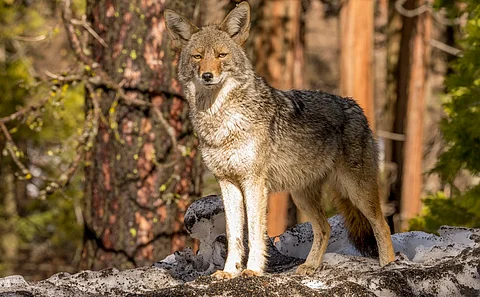

Coyotes (Canis latrans), the canids native to North America, are rapidly spreading in urban areas of the United States at a rate that has left scientists amazed. Now, a study has stated that the species is evolving itself to living alongside humans and traces of this evolution can be seen in its genes.
This is important as it has been historically thought that evolution occurs on vast chronological scales. But scientists now understand that evolution can happen within just a few generations.
The coyote is a species that is living proof of this fast evolution.
“Coyotes are doing really well in urban spaces,” Elizabeth Carlen, a postdoctoral fellow with the Living Earth Collaborative at Washington University in St. Louis and senior author of a study in Genome Biology and Evolution, was quoted in a statement by the university.
“Given the close evolutionary relationship between coyotes and domestic dogs, we leveraged the dog genome to think about what genes could be under selection in urban areas and how they might be changing,” Carlen said.
The ecological differences between urban and rural individuals have been well characterised. However, as per Samantha Kreling, a PhD candidate at the University of Washington and first author of the new study, while the existence of genetic and ecological differences is known, few studies have looked at specific genes or the genome regions that may be affected.
Kreling said the study by her and Carlen looked at candidate genes to investigate for adaptive evolution in urban coyotes.
The statement noted that the candidate gene approach involved researchers identifying particular genes of interest to sequence and compare.
This approach has its advantages. While whole-genome and epigenome sequencing are the gold standard for understanding evolutionary change and adaptation, these methods can be cost-prohibitive — especially for wildlife-focused budgets, according to Carlen.
“Carlen and Kreling’s new study provides examples of life history traits that may be under selection in urban coyotes as well as a list of candidate genes that have the potential to be implicated — including genes related to diet, health, thermoregulation, behavior, cognition and reproduction,” the statement noted.
Both researchers looked at genes related to the coyote’s eating habits.
Coyotes in rural America usually eat rabbits, mice and other small mammals. Their urban counterparts, on the other hand, have easy access to outdoor pet food and human refuse.
“This likely translates into higher consumption of glucose and starches,” said Carlen.
If sugar intake is sufficient to cause insulin resistance and subsequent negative health outcomes, then the genes that help regulate insulin sensitivity and production may be selected for.
Urban coyotes also probably need to be able to digest more starch. Previous studies with domestic dogs have shown increased copy numbers of AMY2B, a gene responsible for amylase production and increased starch digestion efficiency.
The paper titled Adaptation in the Alleyways: Candidate genes under potential selection in urban coyotes, by Carlen, Kreling and Summer Vance was published on December 30, 2024.